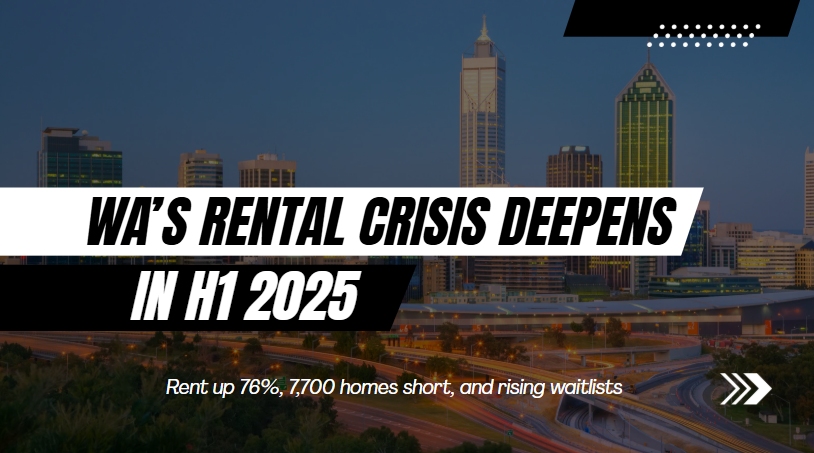WA’s Rental Crisis Deepens in H1 2025
Josh Tay
Last Updated on 08-Aug-2025

If you’ve been watching Perth, average rent is now AUD 740 per week, a jaw‑dropping 76% jump since 2020. That’s an extra A$6,640 per year tenants are paying compared to 2020, well above wage increases averaging AUD 3,000 over the same period.
Despite building over 20,000 new homes in 2024, WA’s best output since 2017, the state still fell 4,000 units short of the National Housing Accord's target, leading to a 7,700‑unit rental shortfall between March 2023 and end‑2024.
For Perth, vacancy rates under 1% for two full years created relentless upward pressure on prices; though vacancy did edge up to around 1.2% by mid‑2025, it still remains the lowest among Australia's capital rental markets.
Today, the vacancy rate has improved slightly, hovering near 2.8% by May 2025, the highest since early 2020—but that only hints at early stabilization, not immediate relief.
What You Should Know Now
1. Renters Losing Big
Nationally, renters have lost an average of A$10,920 per year since June 2020, with Perth tenants paying A$16,640 more annually, suggesting the highest shock in the country.
2. Affordability Crisis of Broad Reach
You don’t need to be low‑income to feel squeezed. Renting itself now burdens even those earning A$30,000/year, especially in Northern WA where up to 55% of income goes to rent.
3. Homelessness & Housing Stress
WA’s homelessness has more than doubled since 2016, with over 2,300 people sleeping rough. And the social housing waitlist has soared; only a fraction are getting housed each year.
Why Global & Singapore Investors Should Pay Attention and Fast
1. Stable Demand, Accelerating Rents
With supply stuck, rents are climbing—and they’re expected to continue rising until at least 2026. For rental‑yield seekers, WA represents a market with real cash flow opportunities and long-term stability.
2. Market Backed by Migration, Education & Lifestyle Drivers
Growth in WA isn’t speculative. The population has grown 4.2% since March 2023, with 85% settling in metro areas. Investors buying for migration, retirement, child education, or own-use will find strong long‑term fundamentals.
3. Supply Lag Ensures a Seller’s Market
Construction times have more than doubled to 15.6 months, adding up to A$100,000 extra per new home. Lower supply + increasing demand = skyrocketing rents, squeezed affordability, and a looming vacancy crisis.
4. High Entry Barrier Before the Ban
Foreign buyer restrictions are tightening across Australia, especially for resale homes. Opportunities exist now to secure investment-grade property before broader bans roll in.
How to Win in This Market
| Strategy | Why It Works for You |
| Buy now in high-demand suburbs with limited vacancy (inner Perth, East Perth, Mount Lawley) | You secure rental income while competition grows |
| Target build-to-rent or mid-density developments | Institutional tenants and stable leases provide reliability |
| Focus on student & key-worker housing near universities/hospitals | These segments face greatest pressure and highest demand |
| Add services or finish touches (e.g. furniture, co‑living) | Differentiates your unit and boosts rent by up to 20% |
| Lock in cap‑rate now before rising interest caps your yield potential | Rates may rise again, so lock your financial structure now |
Perth’s Rental Surge is Not Fear, It's Forward Momentum
This isn't just a crisis, it’s a market signal. If you wait, yields decline, costs increase, and government may step in with stronger controls. Delay is not luxury here; it’s risk.
Let's turn crisis into your investment advantage.
Message us now!